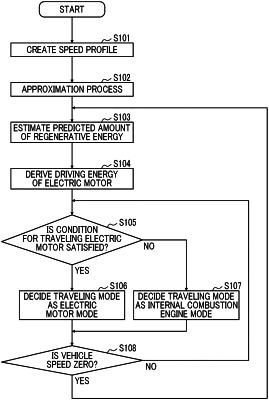| CPC B60W 20/13 (2016.01) [B60L 58/24 (2019.02); B60W 10/06 (2013.01); B60W 10/08 (2013.01); B60W 20/12 (2016.01); B60W 30/18127 (2013.01); B60W 40/105 (2013.01); B60W 2510/246 (2013.01)] | 10 Claims |

|
1. A travel control device mounted on a vehicle, which includes (i) an electric motor and an internal combustion engine that are power sources and (ii) a storage battery that stores energy for driving the electric motor and regenerative energy recovered by regenerative braking of the electric motor, the travel control device comprising
an electronic control unit (“ECU”) comprising a memory storing at least one program and a processor configured to execute the at least one program so as to:
create a speed profile in which a speed of the vehicle is predicted at a plurality of points of time;
estimate, based on the speed profile, a predicted amount of the regenerative energy to be recovered;
decide the power source to be used for traveling;
estimate, based on the speed profile, the predicted amount of the regenerative energy for each period of a plurality of periods divided at timings when the speed of the vehicle in the speed profile is zero; and
for each of the periods, (i) derive driving energy to be supplied to the electric motor based on thermal information indicating a demand related to heat of the vehicle and the predicted amount of the regenerative energy in the period and (ii) decide, based on an amount of the driving energy, that the driving energy is supplied to the electric motor and is used for traveling,
wherein the processor of the ECU is further configured to:
when a length of a first period of the plurality of periods is less than a first length threshold, combine the first period and one or more subsequent consecutive periods that are next after the first period so as to form one connection period that is equal to or longer than the first length threshold;
derive the driving energy to be supplied to the electric motor based on the thermal information and the predicted amount of the regenerative energy in the connection period; and
for the connection period, decide, based on an amount of the driving energy, that the driving energy is supplied to the electric motor and is used for traveling;
wherein the processor of the ECU is further configured to determine whether or not a user of the vehicle intends to decelerate the vehicle; and
wherein the processor of the ECU is configured to decide the power source to be used for traveling:
(1) based on the predicted amount of the regenerative energy;
(2) based on the thermal information;
(3) when it is determined that the user of the vehicle intends to decelerate the vehicle, by
(i) determining whether or not the speed of the vehicle is equal to or greater than a first speed threshold at which a certain degree of regenerative efficiency can be expected,
(ii) determining whether or not power requested by the user is equal to or less than a first power threshold, which is set as an amount of power that can be output by the electric motor, and
(iii) determining whether or not a charge rate of the battery is equal to or less than a first charge rate threshold, which is a charge rate at which an entirety of the regenerative energy can be stored in the battery; and
(4) when it is determined that the user of the vehicle does not intend to decelerate the vehicle, by
(i) determining whether or not the speed of the vehicle is lower than a second speed threshold at which the electric motor is expected to be more efficient than the internal combustion engine, the second speed threshold being greater than the first speed threshold,
(ii) determining whether or not the power requested by the user is equal to or less than the first power threshold,
(iii) determining whether or not energy supplied to the electric motor is less than the driving energy,
(iv) determining whether or not a first time threshold has elapsed since operation of the internal combustion engine was started, and
(v) determining whether or not a power storage amount of the battery is equal to or greater than the driving energy.
|